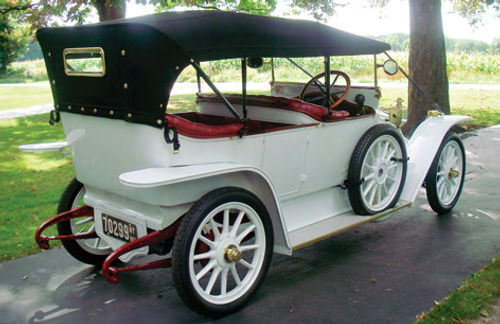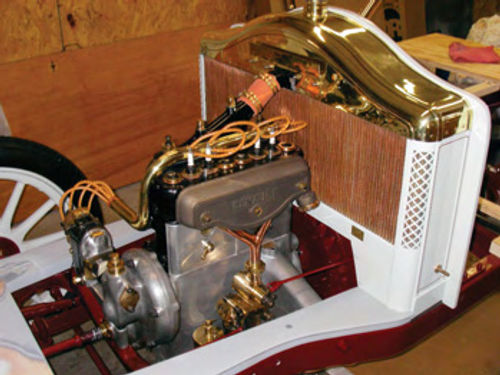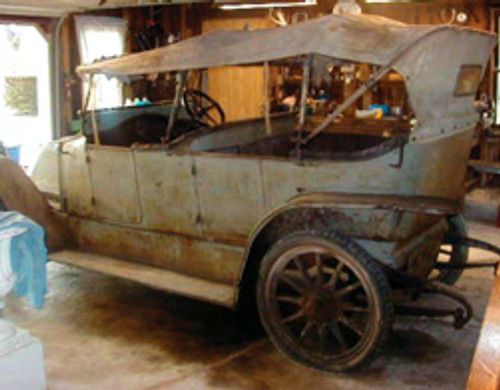A Restorer’s Story 1913 Renault Touring Car
He Went Into the Barn Looking for a Tractor...
ONE DAY, AS I was looking at a jewel, I discovered a diamond in the rough! The jewel was a restored 1937 John Deere tractor that I was considering. The “diamond in the rough,” an old touring car, was sitting in the barn directly behind the tractor. They were located in Washington, Pennsylvania, near my hometown in the western part of the state. In terms of judging the tractor, I knew what I was looking for and looking at. It was a beauty. Asfor the touring car, a Renault with its once-shiny brass turned black, I realized I needed to do some research before coming to the final decision to purchase. This was in November 2003 while visiting my family for Thanksgiving.
The Adventure Begins
I immediately began to trace the history of the car. Then-owner Ed Roberts had inherited the 1913 Renault in 2000 from the widow of a man named Charles Pierce who had lived in the Utica, New York, area and had a bevy of antique cars. When Pierce died, his widow sold many of the vehicles but hung on to the Renault. Upon her death in 2000, the car was willed to Ed Roberts who had worked for Charles Pierce during the 1940s. Roberts Then brought the car from Utica to Washington,Pennsylvania.
At the same time that I was tracing the car’s history, I also contacted several friends who were members of local affiliates of the Antique Automobile Club of America (AACA) and the Horseless Carriage Club of America (HCCA)to find out as much as I could about “brassies,” such as the ease of restoration, whether they knew of any Renault owners that I might contact, and whether they could suggest resources that might be valuable in terms of restoration. I also contacted each club’s headquarters asking if they were aware of any owners of early Renaults. The AACA provided the names of six Renault owners and I wrote to each one. I also joined Renault Fréres. Based in the United Kingdom, it is the official club for owners of pre-1940 Renaults.

With the Renault as the catalyst, I began networking around the world—from Ohio and Michigan in theU.S.,to Switzerland, England, Australia and Canada. The willingness of people to share information and provide support was wonderful! It was the start of many new acquaintances and lasting friendships.
I learned the Renault I was looking at was a 1913 Type DM touring car. Even though the engine was disassembled, the fact that the car was “complete” made it very appealing. With my enthusiasm fueled, I concluded that this early brass touring car was meant for me. So, in March 2004 I purchased both it and the John Deere tractor. After two trips with my trailer, they were both at their new home.
An Important, Missing Part
As I embarked on the restoration, I acquired copies of operations manuals, drawings of the car’s sub-systems, suggestions for grease and oils to use, and information about DM car “idiosyncrasies.”


I began to disassemble the vehicle in April 2004 and created a detailed log book in which I recorded a description of work done, number of hours of work performed, disassembly sequence (order in which parts were disassembled), notes to help simplify the reassembly process, expenses, questions to be pursued and digital photos to document the process each step of the way.
At the same time, I took a closer look at the engine parts to determine how they fit together and how they would be reassembled. The engineer in me is ever so curious about how things work! In doing this, I realized that a critical part was missing—the oil pump gear which mates with the camshaft. In fact, it was the only missing part. Fortunately, I was able to locate a master machinist who fashioned the critical oil pump gear.
A Helpful Encounter
The circumstances of happenstance are amazing! While shopping for 1913 New York license plates in the flea market at the Hershey National Fall Meet, I struck up a conversation with a vendor from the Utica, New York, area, who just happened to know Charles Pierce and the antique cars Pierce owned. “As a matter of fact,” he said, “I believe I have a program from an antique car show that has a picture of your car.” We exchanged addresses and what should arrive a few weeks later but the program from the “Second Central New York Antique Auto Show” July 3rd-11th, 1948. In it was a picture of “our” car as displayed at the time by Charles Pierce.
About That Black Brass…
I have completed the frame-off restoration having done much of this work myself on the premises. I sandblasted, primed and painted the chassis and associated parts. I buffed the brass parts, which were in extremely good condition except for one cowl light needing major repair done by a local metalsmith.
The engine was overhauled by a neighbor, Flathead Sales and Services, that has been doing antique vehicle restoration for over 40 years. The drive train needed very little work—mostly relining of the clutch plate and brakes. I replaced all of the wheel bearings.

The body was in very good shape except for a few areas where rust through occurred. The fenders required major efforts and a craftsman friend assisted me with this. The wood was intact and I was able to refinish and/or construct some wood parts where needed. Wheel rims and wooden spokes were in good shape so I was able to restore them using my own elbow grease. Paint Specialists did the painting of the body, hood and fenders and the pin-striping. The car came to us with much of the top and upholstery intact, which the upholsterer was able to use for patterns.
Going Public With My Work
I completed the restoration of my 1913 Renault DM in July 2009.What a rewarding journey with over 2500 hours of my time invested.
However, I know the adventure is not yet over. Rather, another chapter has begun as we enjoy our restored car. In September 2009, we were invited to display the car at the Glenmoor Gathering of Significant Automobiles in Canton, Ohio, where “Vintage French Front” automobiles (i.e. the swooping fronts popular with many early automobiles such as Renault and Franklin) were given special recognition. In October 2009, the car received a National First Junior Award at the AACA National Fall Meet in Hershey, Pennsylvania.
Some of the Renault’s Uncommon Features
• Uses a direct drive system, characteristic Louis Renault’s first cars,with an engine via a clutch to a gearbox and a universal-jointed prop shaft to a rear “differential” to the back wheels. It’s very similar to a modern rear-wheel drive car. In top gear, the engine “directly drives” the back wheels.
• Has a radiator comprised of 1100 copper tubes located behind the engine.
• The fan and flywheel is one unit mounted between the crankshaft and transmission. The engine compartment is sealed off by a pan underneath resulting in air being drawn through the radiator over the engine and exhausted out the back of the engine compartment.
• The “swooping hood” is an identifying marker of the early Renaults.
















